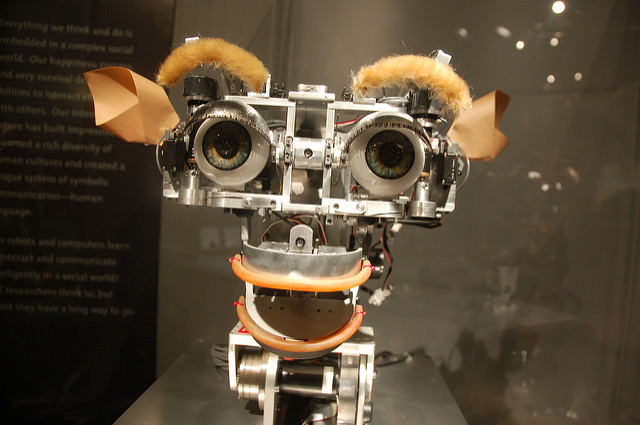
Chapter three of CFM’s TrendsWatch 2017 examines how artificial intelligence—computer programs that mimic human abilities such as complex reasoning, language, and pattern recognition—can be harnessed for museum purposes. In today’s guest post Dexibit CEO Angie Judge previews a session she will chair at the 2018 AAM annual meeting profiling three case studies of museums using AI data analytics for planning and operations. This is one of a series of posts giving sneak peeks at sessions I’ve included in my annual Guide to the Future at the Annual Meeting.
 |
| MIT Museum: Kismet the AI robot smiles at you” by Chris Devers licensed under CC BY-NC-ND 2.0 |
Artificial intelligence is rapidly making its way into our everyday lives. Maybe it recommended the last TV show you watched, or was responsible for routing your recent car journey. Now, it might greet you in the form of a robot at your next museum visit, help your collections team with classifications, or get at a seat at the table during financial planning. One of the most practical applications of artificial intelligence is to forecast a museum’s commercial and visitor outcomes.
Previously, in most museums, predicting critical numbers such as visitation, revenue and capacity was a case of “guess or grind.” Either the museum’s team, in the interests of time, resorts to anecdotal opinion to create a hit or miss guesstimate, or a dedicated analysis team wades through years of data to provide accurate estimations. Such analysis is complicated, because so many elements influence a museum’s performance. While some factors, such as marketing or programming, are within the museum’s control many others, such as tourism trends or the weather, are not. Some factors, such as changing schedules of school terms and regional events, are obvious, yet finicky. And on any given day, all of these elements combine and influence each other to impact the result – the equation is rarely a case of simple math. To make a difficult situation worse, sometimes anecdotal opinion paints a different picture to the numbers – for example, when the significance of cruise ships is masked by the summer high season, misleading future projections.
One of the most powerful aspects of AI is machine learning—the application of algorithms that can learn from and make predictions based on large data sets. Algorithms designed to adapt to a museum’s unique circumstance can be trained on historic performance data to analyze the simultaneous impact of multiple factors and predict how these will play out. Not only can machine learning reduce months of hard work to a few seconds at the click of a button, it produces a more accurate result that helps museum marketers better manage for performance and a more granular forecast (even down to the hour) that assists front of house teams with everything from staff rostering to store inventories.
But using AI is not a case of letting the machine take over. Forecasts are only as intelligent as the data they receive, and need a well-executed analytics foundation. Predictions need to be configured for situations the computer can’t model from historical data, such as the impact of a refurbishment or the resonance of an upcoming exhibition. Data-informed museum management requires trust, so results need to be inspected for accuracy.
Some of the most interesting aspects of forecasting are its by-products. Knowing the fit of a forecasting model is important information for the museum team to understand to what degree a forecast can be relied upon. Understanding the comparative influence of various factors can help decision-making priorities. Seeing the upcoming plan of what’s on in and around the museum is equally useful for museum operations.
Forecasts are especially useful for informing performance management. Forecasts help managers understand projected performance to its goals, an important consideration when setting targets for employees. Once the forecast is created, tracking actual performance against this plan immediately shows where the museum’s execution is under or over expectation, triggering analysis and response by the management team to mitigate or make the most of the contributing situation. To achieve this, the museum needs a dynamic analytics capability in conjunction with forecasting to respond in an agile way to the world around it.
- Predicting museum visitation with Keith Laba, Chief Information and Analytics Officer at Arizona Science Center
- Predicting advance pass redemption and attrition with Heather Hart, Director of IT at the Broad
- Predicting exhibition scenarios with Chris Michaels, Digital Director at The National Gallery, London
Angie Judge is the CEO at Dexibit, delivering big data analytics to predict, analyze and report on visitor experience and venue performance in visitor attractions across North American, UK Europe and Asia Pacific.








